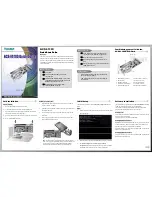
XRF410N™ INSTALLATION
18
In the
Reading Phase
step, set Acquisition Trigger Type to
Periodic
. The period to set
depends on the application speed, the maximum code length, and the maximum pack height.
To guarantee application functioning, two successive acquisitions must have an overlapping
area in the direction of movement at least equal to the maximum code length.
Code Setup
Reading-Phase
General Settings
XRF410N
Model
Decoding
Timeout
Value
[ms]
1
Code
Search
Strategy
Decoding
Strategy
Processing
Mode
Image
Buffer
Size
Acquisition
Trigger
Type:
Periodic
[ms]
Delay on
Internal
Trigger [
s]
2
XRF410N-B0x
Medium res
130
Fast
Fast
Standard
20
45
Master = 0
Slave = 2000
XRF410N-B1x
High res
130
Fast
Fast
Standard
20
35
Master = 0
Slave = 2000
XRF410N-H0x
Medium res
160
Fast
Fast
Standard
20
60
Master = 0
Slave = 2000
XRF410N-H1x
High res
160
Fast
Fast
Standard
20
60
Master = 0
Slave = 2000
XRF410N-H2x
Very High res
160
Fast
Fast
Standard
20
60
Master = 0
Slave = 2000
Table 3 - Default Code Setup and Reading Phase Configuration
Note 1
: Decoding Timeout
The Decoding Timeout default values are set based on a statistical analysis of decoding
times measured on a variety of packs considered typical in various T&L applications.
Decoding Timeout depends heavily on the type of acquired images. As a general rule it is
suggested to set a value about equal to three times the Acquisition Period.
In case an application has difficulty decoding with the default values, it is possible to adapt
the timeout setting, particularly for applications where the objects are homogenous.
For example in the case of very “noisy” objects (i.e. writing, repetitive patterns or reflections
present in the area of the code) it is suggested to limit the Decoding Timeout value to two
times the Acquisition Period, and possibly increase the frame rate to have some image
redundancy.
Note 2
: Delay on internal Trigger
In case of multiple XRF410Ns installed next to each other, it is necessary to set an
Acquisition Trigger Delay between adjacent readers to avoid overexposure due to
simultaneous illumination in the FOV.
In these conditions, for a TOP application it is suggested to set a 2 ms delay for all odd
readers in the network while leaving the Master and all even Slaves without a delay (0 ms).
In TOP-SIDE installations it is left to the installer to set the correct delay to avoid
simultaneous illumination in the FOV from more than one reader.


































